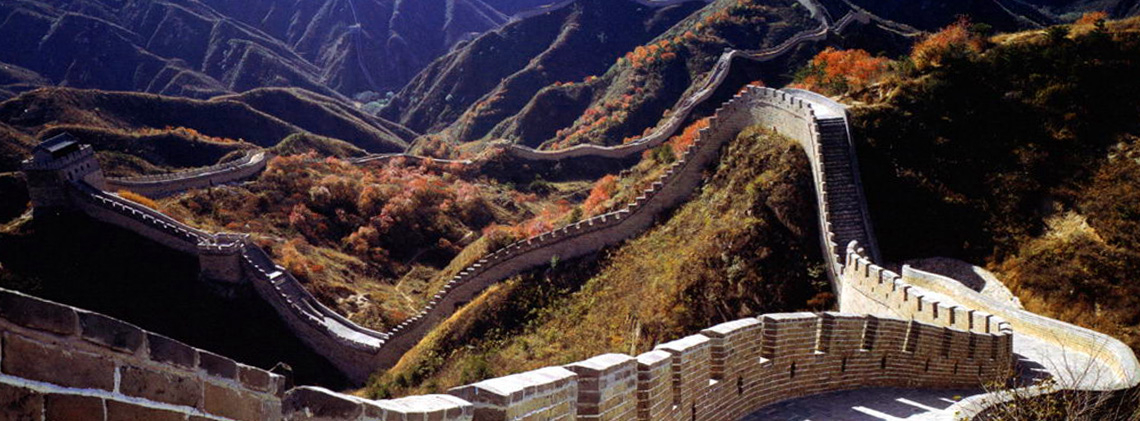
The Great Wall
Splendid
Chi Culture
Topic
The Great Wall
The Great Wall, more than two thousand years old, was constructed to protect China against the incursions of northern nomadic tribes. The entire wall was not built at one time; rather, sections were built and joined at various times throughout history. Over the course of history, the total length of the walls exceeded 20,000 kilometers. The Great Wall, or the “ten-thousand-li wall” as it is known in Chinese, generally refers to the sections built in the Ming dynasty (1368–1644) which have a total length of more than 8,000 kilometers.
The earliest walls date back to around the seventh century BCE during the Eastern Zhou (770–221 BCE). Wars frequently broke out between neighboring states In order to prevent foreign enemies from invading, many countries have also built the Great Wall.
The walls built during the Warring States period (475–221 BCE) were comparatively short. In small states, they might be as short as several hundred kilometers; while, in large states they could extend up to 1,500 kilometers. It was not until Qin Shihuang (First Emperor of the Qin dynasty, 259–210 BCE) unified China that the construction of the Great Wall was started.
Legend has it that in the thirty-second year of his reign (215 BCE), the emperor sent Lu Sheng, a native of Yan, to sea and ordered him to find the immortals said to reside on islands there. Qin Shihuang was hoping to find the method to become immortal himself. Lu returned with a book that said “Hu will destroy Qin.” Qin Shihuang assumed that “Hu” had to be Xiongnu of the north, also known as the Hu people. He immediately dispatched General Meng Tian (d. 210 BCE) with an army of 300,000 soldiers to attack them. The Xiongnu were forced to locate north of the Yinshan Mountains. The following year, Qin Shihuang set up forty-four counties, built frontier fortresses, and started the construction of the Great Wall. After the emperor’s death, his son Huhai (r. 210–207 BCE) arranged for the murder of his eldest brother Fusu (241–210 BCE) and ascended the throne as the Second Emperor of the Qin. The new emperor’s despotic rule caused peasant uprisings that led to the fall of the dynasty. Afterwards, people came to realize that “Hu” in the prophecy actually referred to Huhai.
Only a few sections of the Qin walls are left; they can be found in Gansu, Hebei, and Inner Mongolia. Many sections of the Ming dynasty walls, however, still remain.
The Great Wall was ingeniously designed to give each architectural component a specific function. Of its entry points, the larger ones are called guan or pass, such as the Shanhai Pass and the Juyong Pass, and the smaller ones are known as kou, entry and exit points, such as Xifengkou and Gubeikou. Passes were constructed with defenses and gates and were used to inspect merchants and travelers in peacetime and to repel enemies during war. Fortifications were built at passes and entrances to garrison troops while sentries in the battlements alerted their troops of enemies’ movements by releasing smoke in daylight or lighting fires at night. The place where smoke and fire signals were sent is called a beacon tower. The signal smoke, which was produced by firewood, dry bushes, and wolf dung, was also called “wolf smoke.”
In the twentieth century, archaeologists, excavating the Han defensive walls in Inner Mongolia and Gansu, discovered many bamboo and wooden slips inscribed with writing; these described the life and work of the border guards during the Han dynasty. Among many of their duties were patrolling, making bricks, plastering walls with white clay to protect them against wind and sand erosion, making torches, and breeding dogs.
For more than 2,000 years, these long walls have shielded the Central Plain from wars and contributed to the welfare of the people and their economic development. It is a military project of enormous scale that was unmatched in the ancient world. Its construction and use demonstrate the wisdom and technology of the ancient Chinese people.



